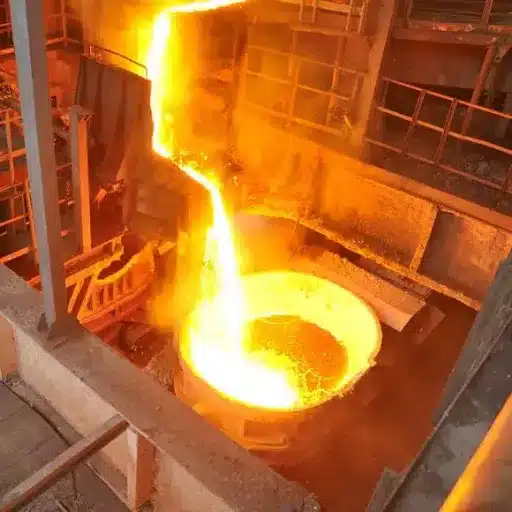Knowing the melting points of steel, metals, alloys, and other materials is very important in many industries from manufacturing and construction to aerospace and engineering. The temperature at which a material is transformed from solid to liquid can determine its usability, durability and performance in different applications. This blog post will uncover the melting point science by discussing the materials, their melting temperatures and the factors which influence these key properties. If you are a professional in the industry or just a curious learner, the information in this guide will provide you with insights on why melting points are significant and how they have an impact on us. Please stay tuned as we will be revealing the interesting facts about these important materials and their properties.
Melting Points – Introduction
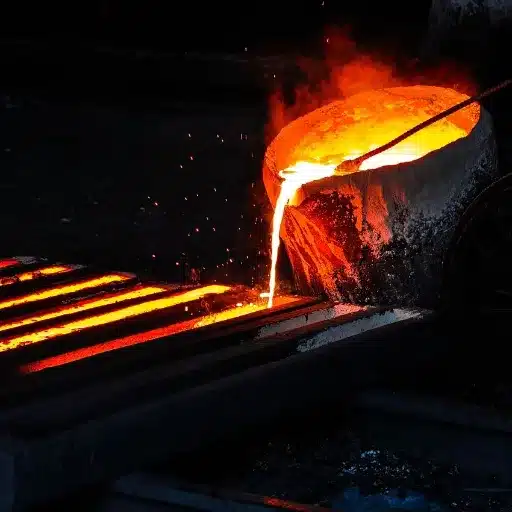
Melting points are the most essential thing because they show the temperature at which a solid turns into a liquid, thus determining its usability in different applications. Through melting point analysis, I am able to choose the right materials for various purposes, and also to predict their performance in different situations.
Melting Points – The Major Factor in Knowledge
Melting points are a major factor in knowledge in all the scientific and industrial fields business up and down the melting points across the world. Mainly melting points of the products give and take the key to the thermal stability, purity and performance of the material. For example, in the drug industry, the melting point of a drug compound is itself a test determining the purity of that drug and quality if any. The impurity in a substance melts and stretches the melting range lowering it hence this property becomes a very important parameter for quality control.
Moreover, metals and alloys take on the melting point data precision and their manufacturing processes ultimately steal their life through melting point. For instance, pure iron’s melting point is about 1,538°C (2,800°F), while the melting point of the widely-used alloy called steel shows wide variation according to its composition. Such variations totally affect the areas of application like buildings, machines, and electronics. Also, semiconductor industries are handling silicon (with a melting point of 1,414°C or 2,577°F) rely on the melting point accuracy during production, and thus supply electronic components.
Steel and Other Metals – A Brief Overview
Steel, an iron-carbon alloy, is among the top materials which have excellent physical properties such as strength, durability, and versatility. Depending on its carbon content and alloy mixture, steel with a melting point of about 1,370–1,510°C (2,500–2,750°F) is extensively used in construction, transportation, and manufacturing. For instance, chromium-containing stainless steel that is corrosion resistant and widely used in medical instruments, processing food and architecture etc., is very much inevitable.
The same way, other metals like aluminum and copper are also significant in industrial and everyday applications. For example, aluminum which has a melting point of 660°C (1,220°F) is rust-free, and light in weight making it the most preferred material in the fields of aviation and packaging. On the other hand, copper, which has the best conductivity and melts at 1,085°C (1,984°F), is very much in demand for electrical wiring, plumbing, and also for renewable sources like solar panels and wind turbines, where it is used as an energy-efficient conductor.
Understanding Steel Composition
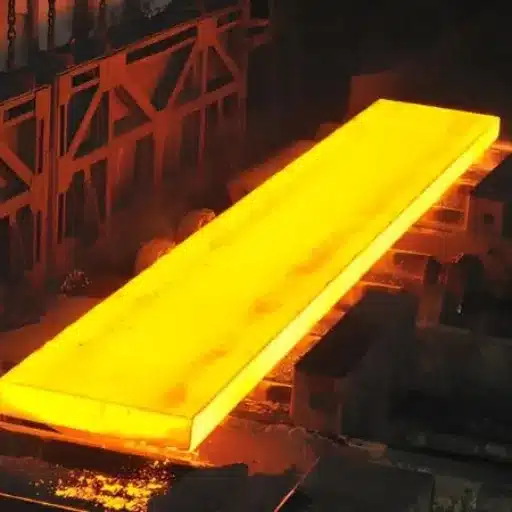
Steel is mainly an alloy of iron and carbon, but with the addition of minor amounts of other elements like manganese, chromium, or nickel, the most desired properties can be made prominent. The composition of steel is sometimes strictly different depending on the use it is going to serve; the industry might ask for a certain combination of properties to be present, so it does not hesitate to veer between strength, durability, and flexibility.
Elements in Steel Alloys
Steel is an alloy mainly made up of iron, while carbon is the major hardening element. The addition of the other elements has a significant effect on the properties of steel, which, in turn, gives rise to a whole range of different steel types, each of them suited to a specific application. The list below represents the main ingredients that typically go into making steel alloys along with their functions:
| Element | Typical Range | Function |
|---|---|---|
| Carbon (C) | 0.02% – 2.1% | Increases hardness and strength; higher percentages cause loss of ductility |
| Manganese (Mn) | 0.3% – 2% | Contributes to toughness, wear resistance, and hardenability; neutralizes harmful effects of sulfur |
| Chromium (Cr) | 10.5% – 18%+ | Protection against rust; provides strength at high temperatures |
| Nickel (Ni) | Up to 8%+ | Enhances corrosion resistance, toughness, and capability to survive extreme heat |
| Silicon (Si) | Under 0.5% | Enhances strength and acts as deoxidizer in steel-making process |
| Molybdenum (Mo) | 0.2% – 5% | Increases strength, resistance to rust, and hardness at high temperatures |
| Vanadium (V) | 0.1% – 2.5% | Increases strength, toughness, and wear resistance |
| Copper (Cu) | Up to 1% | Provides better resistance to corrosion, especially in outdoor steels |
Factors Affecting the Melting Temperature of Steel
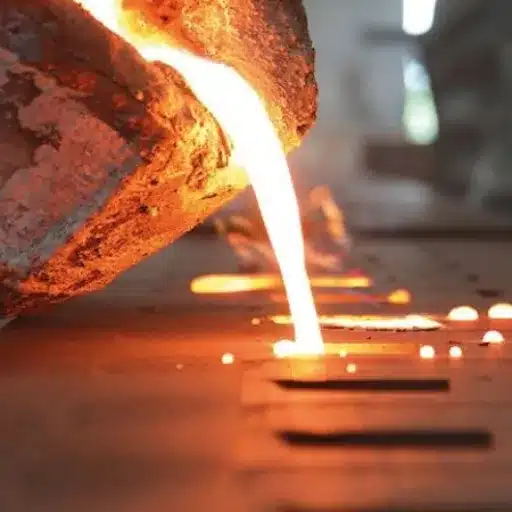
The melting temperature of steel varies with its chemical composition, in particular with the addition of alloying elements such as carbon, manganese, and nickel. The latter can either bring the melting temperature down or push it up depending on their nature and amount. Additionally, the presence of impurities and the particular production method are also involved in determining the melting temperature.
Influence of Alloying Elements
Steel melting points are greatly affected by alloying elements, which are added to change the properties of steel. Pure iron melts at about 1,538°C (2,800°F) but the melting point varies when different substances are added, either raising or lowering the melting point based on their properties and their amount. For instance, carbon, a major ingredient in steel, firstly tends to lower melting point and produce hardness and strength at the same time, which shows up in steels of high carbon content that often melt around 1,250–1,450°C (2,282–2,642°F).
Besides, other alloying materials like chromium, nickel, and manganese are also presented with their individual effects. For instance, chromium which is frequently employed in stainless steel, creates a protective atmosphere against corrosion and may slightly elevate the melting point. Nickel atom is known to enhance the toughness of the finished product and so generally, it keeps the steel’s structure from deteriorating at high temperatures but does not have a noticeable impact on melting point. Manganese, which is usually added mainly for its deoxidizing ability, can lower the melting point too because of its interaction with sulfur.
Impact of Carbon Content
Low-Carbon Steel (Mild Steel)
Carbon Range: 0.05% to 0.25%
This steel class has very high ductility and malleability. Its less active nature makes it easier to shape and weld, and thus it is mainly used for structural frames, vehicle body panels, and pipes.
Medium-Carbon Steel
Carbon Range: 0.25% to 0.60%
Has the property of being both ductile and strong at the same time. This steel is mostly used where a fair strength and resistance to wear are required; parts like gears, axles, and machine tools are made from it.
High-Carbon Steel
Carbon Range: 0.60% to 1.5%
Full of hardness and strength so it is used for making tools, cutting devices, and springs. The high carbon content makes it less weldable and it becomes brittle in some cases.
Melting Points of Metals and Alloys
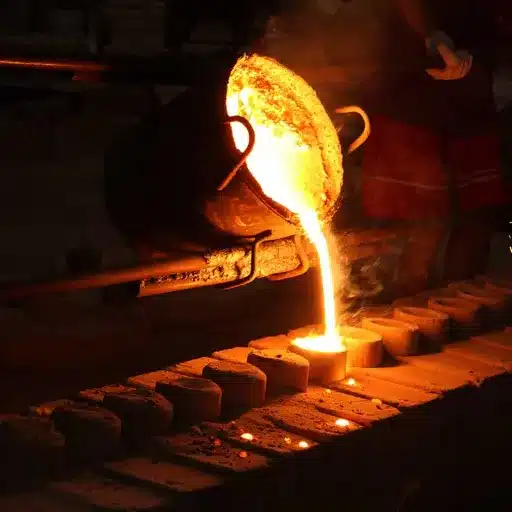
The melting points of metals and alloys are, I believe, directly influenced by their composition. While pure metals typically exhibit their melting points, the scenario is different with alloys as they have a melting range that results from a mixture of elements. In a way, this variability is the same as having a strong point in different applications.
Case Studies: Specific Alloys and Their Melting Points
1. Brass (Copper-Zinc Alloy)
Brass is an alloy that is extensively employed and mainly consists of copper and zinc. The melting point of brass usually varies from 900°F to 940°F (480°C to 510°C) based on the amount of zinc in the mixture. For example, an alloy with 30% zinc will have a lower melting point in contrast to one containing more copper. The lower melting point characteristic of brass makes it an excellent choice for applications like plumbing fittings, musical instruments, and decorative pieces, where easy casting and shaping are critical factors.
2. Stainless Steel (Iron-Chromium-Nickel Alloy)
When one speaks of stainless steel, one speaks of a mixture that is both versatile and resistant to corrosion while preserving its structural integrity. The melting point range, which is around 2,500°F to 2,800°F (1,370°C to 1,540°C), is largely attributable to the chromium (usually 10.5% or more) and nickel content, which not only adds up the temperatures but also the strength of the alloy. This makes stainless steel a material of choice in construction, automotive, and cookware industries. The variations in composition not only allow for customizing according to specific needs but also the existence of surgical-grade stainless steel, which is durable as well as biocompatible.
3. Aluminum Alloys
Aluminum, in most cases, is alloyed with silicon, copper, and magnesium, and thus it has a melting range which is lower than that of most metals. Generally, the melting point of the aluminum alloys is in the range of 865°F to 1,240°F (463°C to 671°C) depending primarily on their compositions. Being lightweight, these alloys also have the ability to be easily machined and are corrosion resistant to a good degree; thus they are widely used in the aerospace, transportation, and packaging industries.
4. Titanium Alloys
The titanium alloys, which mainly contain aluminum and vanadium, are identified by their high strength-to-weight ratio coupled with resistance to very high temperatures. The melting point for titanium alone is about 3,034°F (1,668°C). Nevertheless, when it comes to titanium alloys, they do exhibit slightly lower melting points but still possess amazing heat resistance. The properties of titanium alloys make them ideal for incorporation in aircraft engines, medicine implants, and high-end sports equipment.
Applications and Implications of Steel’s Melting Point in the Industry
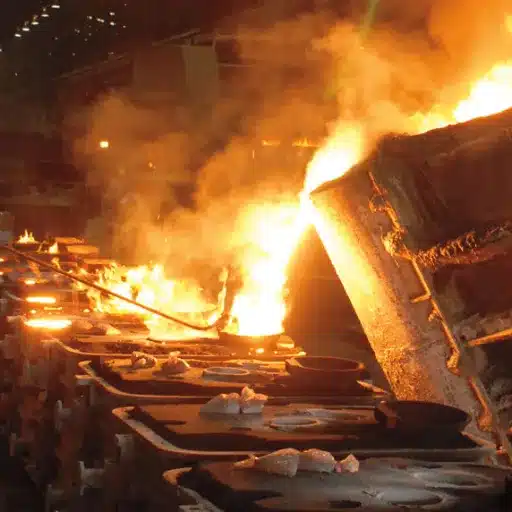
I would say that the melting point of steel, which is generally about 2,500°F (1,370°C), depending on the alloy, is one of the factors that decide the industrial uses of steel. Because of the melting point, steel can be used in very high-temperature applications without losing its stiffness, thus making it suitable, besides construction, mainly for automotive and manufacturing. Also, it is used in tools and machines that are subjected to extreme heat and have an excellent durability requirement.
Role in Manufacturing and Fabrication
Steel’s melting point, generally between 2,500°F and 2,800°F (1,370°C to 1,540°C), is of utmost importance in the manufacturing and fabrication industries. Steel, which is a material of choice for such impressive applications, holds up to 1,000°C of melting point-rich metal as a paragon of good strength and structural endurance even under the fiercest of fire conditions, thus making it quite usable for the hot-end of the whole process fanning out (e.g. forging).
Casting and forging are among the most critical sectors in steel manufacturing where the melting point of steel comes in handy. Steel for casting is heated to a point above melting and then poured into molds, thus getting intricate shapes with precision for metallurgically demanding applications. Forging, on the contrary, involves heating a metal to a point where it is malleable, and then it can be shaped into gears or shafts, e.g., during the component manufacturing stage, while still maintaining the well-known exceptional durability of steel.
Importance in Construction and Engineering
The steel industry is supplying the world construction and engineering with the main raw material that is very strong, long-lasting, and easy-to-work-with at the same time. The high tensile strength of steel is of primary importance in the construction of skyscrapers, bridges, and other massive infrastructures that need to support the weight of the structure, and also withstands the pressure exerted by environmental factors (e.g. wind, earthquake, etc.) and thus their lifespan is extended. The World Steel Association gives fresh data that tells the construction sector consumes more than 50% of the global steel production, which deepens and strengthens the argument of this sector being the key to modern growth.
You cannot even think of taking away steel’s biggest advantages – it is the flexibility and range. It can be produced in various grades and alloys, which makes it completely possible to create the desired steel characteristics by introducing, for instance, anti-corrosive properties or ductility amplitudes that are above the regular range. For instance, at the very beginning, it was assumed that the only material one can work with outdoors should be stainless steel, however, later it became apparent that the material of choice for the non-visibility and harsh environment is high-strength, low-alloy steel. Besides, the innovation of prefabricated steel components has accelerated and made construction cheaper and hence more accessible.
Reference Sources
-
Industrial Metal Service
- Title: What Is the Melting Point of Steel?
- Description: This source explains the melting temperature range of steel (1370°C to 1530°C) and discusses how the composition of steel alloys affects its melting point.
- Link to source
-
SteelPro Group
- Title: What Temperature Does Steel Melt?
- Description: This article provides a detailed overview of steel’s melting temperature range and its dependence on the alloy’s composition.
- Link to source
Frequently Asked Questions (FAQs)
What is the melting point of steel?
The melting point of steel is not the same for all kinds of steel, but normally it is around 1370°C to 1500°C (2500°F to 2732°F). The melting point temperature is affected by the percentage of carbon and other alloying elements in the steel.
How does the melting temp of steel change with different alloys?
Different alloys can cause very different changes in the melting temp of steel. For example, the melting point of carbon steel is quite different from that of stainless steel because of the different elements in the steels. The melting point of the alloy can either be lowered or raised depending on the elements added.
What is the process of melting steel?
Steel melting means the heating of the steel up to the melting point in the furnace. The process consists of the atomic structure of the steel changing from solid to liquid state and the steel getting ready to be cast into different shapes.
How do the melting points of metals compare?
The melting points of metals are different from each other and this can be nicely seen in a melting point chart. For instance, if the melting point is high for steel, it is very low for aluminum among the metals. The knowledge of these disparities is necessary for metallurgy and material selection.
What factors affect the exact melting point of steel?
The melting point of steel can be determined by the same factors that include the carbon content, other alloying elements, and the purity of the metal. High carbon content usually leads to stronger steel but at the same time, it can make the melting point lower.
What happens to steel at its melting point?
Steel at its melting point experiences a transformation in which the solid becomes liquid. This change enables a number of applications like casting and shaping the metal according to the desired forms.

